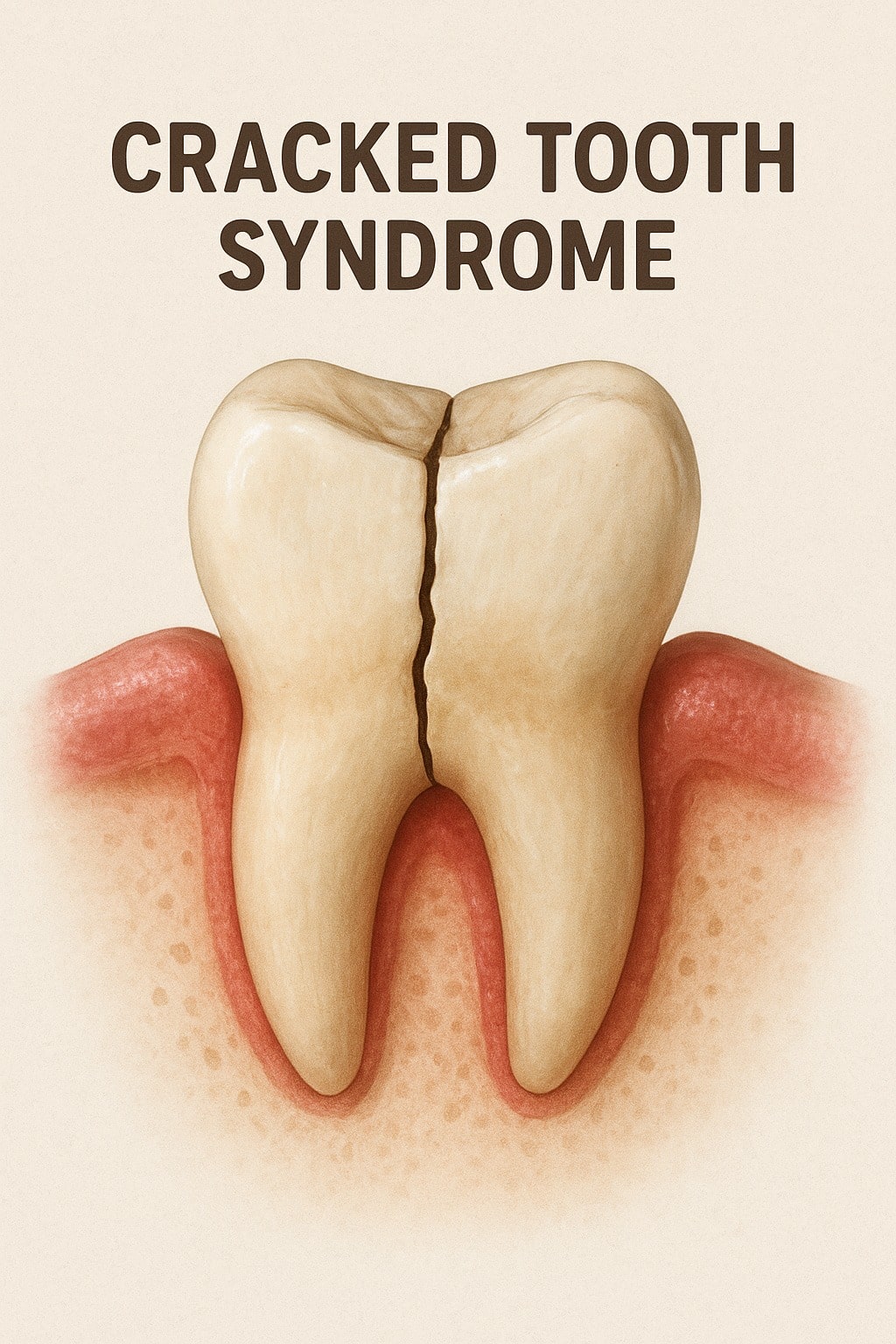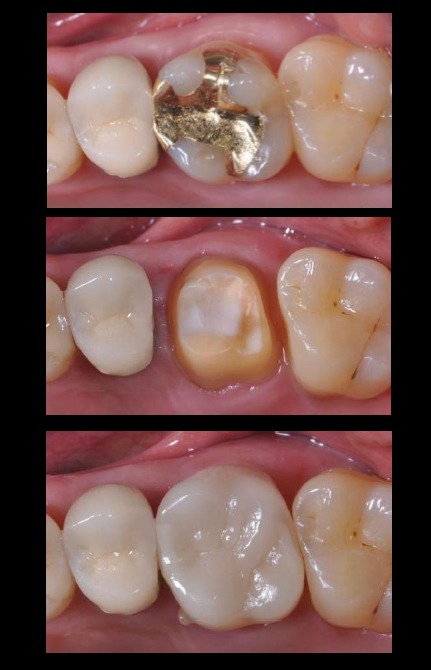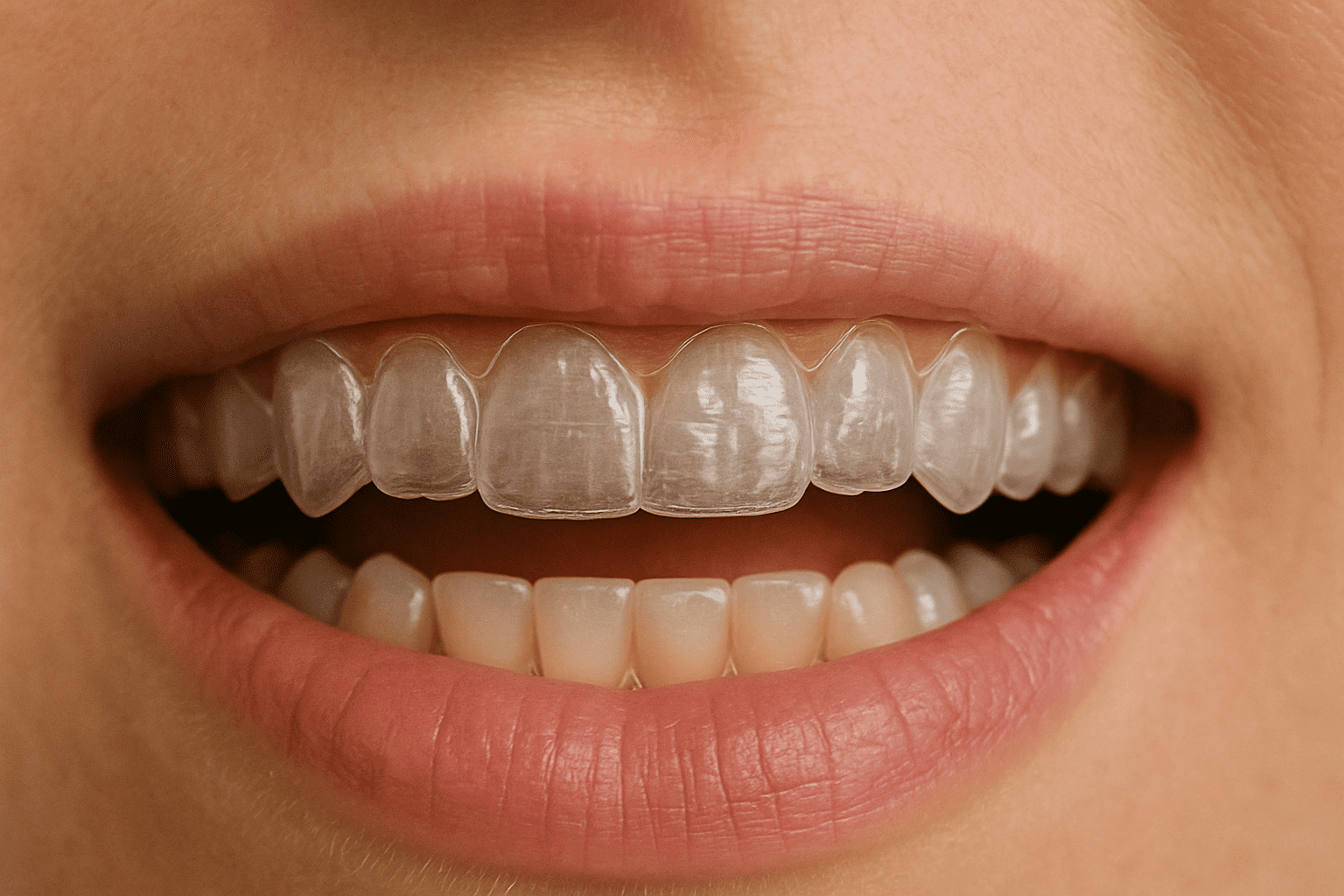What Is Cracked Tooth Syndrome?
Feeling sharp pain when biting? We’ll explore cracked tooth syndrome, its causes, symptoms, and treatment options to save your tooth and relieve discomfort.

Ever felt a sudden sharp pain when biting down, only to have it vanish moments later? That mysterious come-and-go tooth pain might be cracked tooth syndrome (CTS), a common dental condition that's often tricky to spot but important to fix.
At Minty Dental, we see patients with cracked teeth regularly. This guide will help you understand what CTS is, how to spot it, and what treatments can fix it.
What Is Cracked Tooth Syndrome?
Cracked tooth syndrome means you have an incomplete fracture that starts at the chewing surface and runs downward. Unlike a chipped tooth (where a piece breaks off) or a split tooth, CTS involves a crack that hasn't separated the tooth into pieces yet.
Dental specialists worldwide generally classify five types of cracked teeth:
- Craze lines: Tiny surface cracks in enamel only. Usually harmless and painless.
- Fractured cusp: A crack that typically starts around a filling and breaks off part of the tooth's chewing surface. Doesn't usually damage the pulp.
- Cracked tooth: An incomplete crack from the chewing surface toward the root. Can be painful and may affect the pulp.
- Split tooth: A tooth completely split into separate parts, often from an untreated crack that worsened over time.
- Vertical root fracture: Cracks that begin in the root and extend upward. Often hard to detect until the infection develops.
The main difference between CTS and other dental problems is how it behaves. Unlike a cavity or gum disease that causes steady pain, cracked teeth typically produce sharp, brief pain that comes and goes, especially when you bite down and then release pressure.
Cracks most often occur in molars and premolars (back teeth), since they bear the brunt of chewing force. Lower first molars are particularly vulnerable due to their location and the stress they experience.

Common Causes of a Cracked Tooth
Several factors can cause teeth to crack:
Chewing Hard Objects
Biting down on hard items like ice, hard candy, popcorn kernels, or pen caps puts too much force on your teeth. These seemingly harmless habits can create hairline fractures that get worse over time.
Teeth Grinding and Clenching (Bruxism)
Many people grind their teeth during sleep or stress. This constant pressure can eventually cause cracks. If you wake up with a sore jaw or headaches, you might be grinding at night.
Large Fillings or Previous Dental Work
Teeth with large fillings are more likely to crack. The more original tooth structure that's been replaced, the weaker the tooth becomes. Root canal treated teeth without crowns are especially at risk.
Sudden Temperature Changes
Switching between very hot and cold foods can stress your tooth enamel through expansion and contraction, potentially leading to cracks.
Age-Related Factors
Teeth naturally become more brittle with age. People over 50 face higher risk due to years of use and wear.
Dental Trauma
Direct injuries to the mouth from sports, accidents, or falls can cause immediate cracks or create weak spots that develop into cracks later.

Recognizing the Warning Signs
Knowing what to expect may help you preventing CTS to develop further
The Distinctive Pain Pattern
The telltale sign of CTS is a specific type of pain that:
- Happens when you bite down and then release pressure
- Comes and goes rather than staying constant
- Can be hard to pinpoint to a specific tooth
- Often triggers with certain foods (especially hard or crunchy items)
This distinctive "rebound pain" occurs because when you bite down, the crack widens slightly, irritating the pulp inside. When you release pressure, the crack quickly closes, causing a sharp, sudden pain.
Additional Symptoms
Beyond the characteristic pain, you might also notice:
- Temperature sensitivity: Sharp reactions to hot, cold, or sweet foods
- Gum swelling: Around the affected tooth
- Difficulty chewing: Avoiding certain teeth
- Random sharp pains: That seem to occur out of nowhere
Unlike cavities or gum disease that cause steady pain, CTS is known for inconsistent, sometimes bizarre symptoms that come and go. This is why many people delay treatment: the temporary pain can make you think it's not serious.
How We Diagnose Cracked Tooth Syndrome
Diagnosing CTS is challenging because cracks are often invisible. At our London clinic, we use several techniques:
Bite Test
One of our most reliable tools is the bite test. We'll ask you to bite on a special instrument called a "Tooth Slooth" that applies pressure to specific parts of your tooth. If biting or releasing causes pain, it helps confirm our suspicion and locate the crack.
Visual Examination
We carefully examine your teeth using magnification and bright light. We look for tiny hairline cracks or subtle signs like worn enamel that might point to a crack.
Dental Dye
Sometimes we apply a special dye that seeps into cracks, making them more visible. This helps detect cracks that aren't otherwise apparent.
Transillumination
Using a bright light aimed through the tooth, we can sometimes spot a crack as it blocks light transmission. This works similar to how a flashlight beam would be interrupted by a crack in glass.
Dental X-rays
Standard X-rays don't always show cracks (especially vertical ones), but they help rule out other conditions like decay or abscesses that might cause similar symptoms.
Removal of Old Restorationsgum
If needed, we may remove existing fillings or crowns to directly inspect the tooth structure underneath. This sometimes reveals hidden cracks.
Treatment Options: From Simple Fixes to Full Restoration
The treatment depends on the crack's location, depth, and severity:
1. Bonding for Minor Cracks
For small, superficial cracks, we might use composite resin bonding to fill the crack and prevent worsening. This tooth-colored material is applied directly to the crack, hardened with a special light, and shaped to match your natural tooth.
2. Dental Crown for Moderate Cracks
For most cracked teeth, a crown (sometimes called a cap) is the best choice. A crown covers the entire visible portion of the tooth above the gumline, holding cracked segments together and preventing them from separating when you chew.
The process typically involves:
- Removing a small amount of tooth structure
- Taking impressions for the custom crown
- Placing a temporary crown
- Fitting and cementing the permanent crown (usually made of porcelain, ceramic, metal, or a combination)
A properly fitted crown restores both function and appearance while protecting the tooth from further damage.

3. Root Canal Therapy for Deep Cracks
If a crack extends into the pulp (the inner chamber with nerves and blood vessels), you'll likely need root canal therapy before getting a crown. During this procedure, we:
- Remove the damaged pulp
- Clean and disinfect the root canals
- Fill the canals with a biocompatible material
- Seal the tooth
- Place a crown to protect the treated tooth
Root canal therapy relieves pain and saves teeth that might otherwise need extraction.
4. Extraction for Severe Cracks
Not all cracked teeth can be saved. If a crack extends below the gumline, into the root, or if the tooth has split completely, extraction may be the only option. The good news is that we have excellent replacement options:
- Dental implants (titanium posts surgically placed in the jawbone that support a replacement tooth)
- Dental bridges (prosthetic teeth anchored to adjacent teeth)
- Partial dentures (removable replacements for multiple missing teeth)
We always aim to save your natural tooth when possible, but when extraction is necessary, we'll help you choose the best replacement.
Recovery and Prognosis
The outcome of treatment depends largely on how quickly the crack is addressed:
- Short-term recovery: Minimal discomfort for a few days after treatment
- Long-term outlook: Excellent for craze lines and fractured cusps treated with crowns
- Monitoring: Regular check-ups to ensure the treatment remains effective
The success rate for cracked teeth treated with crowns is about 80-85% if caught early. However, teeth with cracks extending into the root have lower success rates, around 50-60%.
Preventing Cracked Teeth
While not all cracks can be prevented, you can reduce your risk:
Custom Mouthguards
If you grind your teeth at night, a custom-fitted nightguard can help absorb forces that would otherwise stress your teeth. Athletic mouthguards are essential during contact sports.
Smart Eating Habitscrow
Avoid biting hard objects like ice, unpopped popcorn kernels, or pens. Be careful with foods like olive pits or fruit stones that might be unexpectedly hard.
Regular Dental Check-ups
Regular exams allow us to spot small cracks before they become major problems, potentially saving you from extensive treatment later.
Frequently Asked Questions About Cracked Tooth Syndrome
Can a cracked tooth heal on its own?
No, teeth can't heal cracks naturally. Unlike bones, teeth don't have a blood supply to deliver healing cells to the crack site. Once a crack forms, it won't repair itself, and will likely worsen over time if untreated.
Is a cracked tooth a dental emergency?
It depends on severity. If you have significant pain, the crack is clearly visible, or a piece has broken off, seek emergency care. Even if the pain is mild or comes and goes, make an appointment soon to prevent the crack from worsening.
How long can a cracked tooth last without treatment?
This varies widely. Some minor cracks may remain stable for years, while others can progress rapidly, leading to infection or tooth loss within weeks or months. The unpredictability makes prompt treatment important.
Will I need a root canal for my cracked tooth?
Not always. If the crack hasn't reached the pulp, a crown might be enough. However, if you have prolonged sensitivity to heat and cold, spontaneous pain, or pain that persists after eating, the pulp may be affected, increasing the likelihood of a root canal.
How can I tell if my tooth is cracked or if it's something else?
The distinctive pattern of pain—sharp when biting down or releasing pressure, and coming and going rather than constant—often points to a cracked tooth. However, the symptoms can mimic other dental problems like decay or gum disease. Professional diagnosis with our specialized tools is essential.
Don't Ignore That Twinge
If you suspect a cracked tooth—perhaps you've noticed pain when biting, sensitivity to temperature, or discomfort that comes and goes—don't wait to see if it resolves itself. Early treatment is key to saving your tooth and preventing bigger problems.
At Minty Dental in London, we have the expertise and tools to diagnose and treat cracked teeth effectively. The sooner you seek treatment, the better your chances of keeping your natural tooth and avoiding more invasive procedures.
Schedule an appointment today if you're experiencing any symptoms of cracked tooth syndrome. Your smile is worth it!






